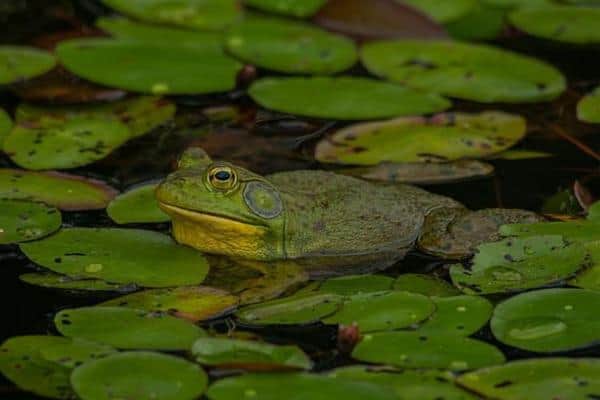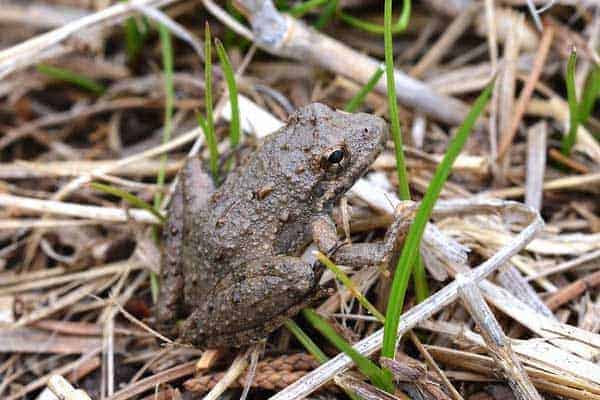Frogs make up the largest group of amphibians, together with toads. Amphibian classification refers to animals that can live both on land and water. Frogs are cold-blooded vertebrates, meaning they have backbones but don’t have scales.
But, what we’ll tackle here, are frogs that live in water. Some frog species spend most of their lives underwater and some on land. Although this can be a rare occurrence, there are particular types of frogs that live in the water.
Aquatic frogs belong to the Pipidae family, which are native to humid and warm regions of South America and Africa.
8 Frogs That Live in Water
Aquatic types of frogs primarily inhabit water, unlike arboreal frogs that reside in trees and terrestrial frogs that live on land. These frogs are often seen in lakes, ponds, rivers, bogs, marshes and streams.
Let’s dive more into these frogs below!
1. American Bullfrog

Scientific name: Lithobates catesbeianus
American bullfrogs are large frog species and can be found throughout North America. They are highly aquatic frogs that love to submerge into still and shallow waters. For their features, they have a large tympanum (eardrum) and usually have brown or olive green skin with a yellow belly.
You can also see some spots on their hind legs. Bullfrogs can grow between 7-inches and to 10-inches (18 to 25cm). Adult bullfrogs are known to be ferocious carnivores.
Snakes, mice, and other insects are what satisfy their appetite.
2. Blanchard’s Cricket Frog

Scientific name: Acris crepitans
The Blanchard’s Cricket Frog is a tiny and semi-aquatic frog that has warts on its back. It’s usually brown, tan, or green colored skin with yellow, black, orange or red markings. You can also see a triangle between their eyes and dark bands around their thighs.
The Blanchard’s Cricket Frog has webbed hind feet and small terminal disc toe pads. They often live along the edges of lakes, streams, ponds, rivers, and other bodies of water.
Blanchard’s cricket frogs are common in Canada, and it is the most aquatic type of tree frog in North America. This frog species often mate during warmer months, from late Spring to the End of Summer.
3. Leopard Frog

Scientific name: Lithobates pipiens
The Northern Leopard Frog’s appearance is similar to a leopard, having leopard-like spots across its back and legs. These frogs are found in Florida to Ontario, Canada and grow 3 to 5 inches. They are also typical for anatomical dissections, and this species gradually becomes rare due to over-harvesting.
The Northern Leopard frogs are often sighted in streams, lakes, wet prairies, and ponds. They are also called “meadow frogs” because they wander away from the water during Summer. This species is native to the Nearctic region, found throughout North America from Hudson Bay down to Oregon.
4. African Clawed Frog

Scientific name: Xenopus laevis
The African Clawed Frog seems like a fan of water since it rarely leaves it. This frog has muscular hind feet and short claws. What’s interesting about this frog is that it is tongueless and toothless!
The African Clawed Frog relies on hyobranchial pumps to push its food down its throat. This frog is entirely carnivorous, preying on the small and weak animals that cross its path. Sometimes, African Clawed frogs participate in cannibalism, eating their eggs, tadpoles, and froglets.
5. Western Clawed Frog

Scientific name: Xenopus tropicalis
The Western Clawed Frog species is often mistaken for the African clawed frog. It is medium-sized species with a flat body and snout that is 1.1 to 2.2” long. Their eyes are bulging high on their head, and underneath their eyes, there is a short tentacle.
Male Western Clawed frogs are smaller compared to females. It is also known as Tropical clawed frogs and is very common for being helpful in genetic studies and genome sequencing because of their atypical genetic makeup. Western Clawed frogs are hardy, easy to breed and can be captured quickly.
6. Green Puddle Frog

Scientific name: Occidozyga lima
Another species of frog that lives in water is the Green Puddle Frog. The Green Puddle Frog comes with names such as Rough-skinned Floating Frog and Pointed-tongued Floating Frog. This midget frog is often sighted in shallow forest pools, creeks, slow-moving rivers, and marshlands.
It has an appearance of a thick body, large head, short snouts, and bulbous eyes. Like other aquatic Anurans, Green Puddle Frogs spent their entire lives in water with only their head showing.
The Green Puddle Frog is native to China, India, Thailand, and Cambodia. They are also not picky eaters, for they feed on small insects like worms, flies, and crickets.
7. Surinam Toad

Scientific name: Pipa pipa
The Surinam Toad is another frog that lives in water. It has a flat body, triangular head, and nostrils at the end of its snout. The skin of Surinam Toad is rough and spiky, and usually, they come in mottled colors such as brown, tan, or olive.
Surinam Toad has webbed feet, and each finger has tiny star-shaped tips making them known as star-fingered toads. These frogs live throughout Central and South America, often in subtropical and tropical forest pools and swamps.
The Surinam Toads are also known for their out-of-the-standard reproduction method. Once a male and female Surinam Toad are made, the female will release her eggs for the male to fertilize. The male will fertilize the eggs with his sperm, pushing them to the female’s back.
Once the eggs have stuck to the female’s skin, she will grow a layer of skin to protect and incubate the eggs. Once the eggs have hatched, they will emerge from the female’s back.
8. African Dwarf Frog

Scientific name: Hymenochirus
Another frog that lives in water is the African Dwarf Frog, considered to be the fully rare aquatic amphibian. Most of their lives are spent underwater, but they generally go to the surface to breathe since frogs don’t have gills and can only breathe through their skins.
Its skin color varies from olive-green to brown-green, and it can grow up to 2 to 3 inches. What’s unique about this African Dwarf Frog is that they eat through their feet.
The lines on the sides of their body are used to pick up vibrations, which is how they can hear! Also, they feed dead bugs, whereas other frog species only eat live food.



